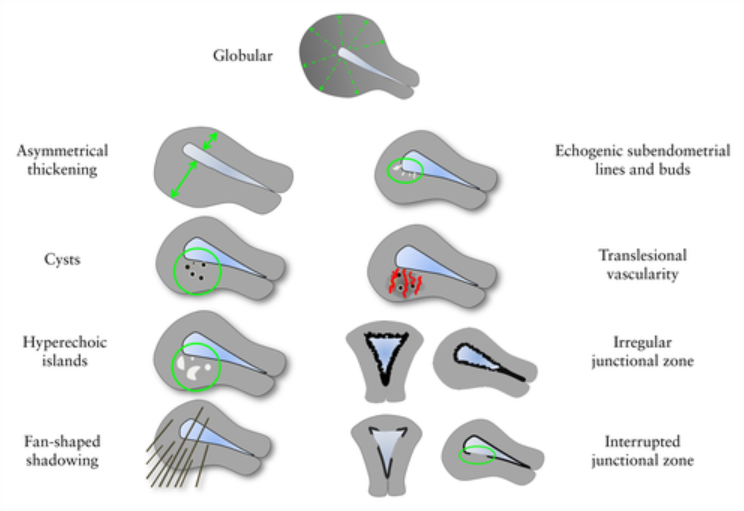Η αδενομύωση της μήτρας είναι μια συχνή γυναικολογική νόσος που σχετίζεται με βαριές και επώδυνες περιόδους καθώς και υπογονιμότητα. Πρόσφατες εξελίξεις στις μεθόδους απεικόνισης μας επιτρέπουν πλέον να διαγνώσουμε την αδενομύωση με το κλασσικό γυναικολογικό υπερηχογράφημα (διακολπικό), ανοίγοντας, έτσι τις πόρτες για την εφαρμογή των μεθόδων αντιμετώπισης της αδενομύωσης.
Υπάρχουν, όμως, συγκεκριμένα κριτήρια με βάση τα οποία μπορούμε να βάλουμε, με σχετική ασφάλεια, την υπερηχογραφική διάγνωση της αδενομύωσης; Αν και σε πολλές περιπτώσεις, η διάγνωση παραμένει εμπειρική, βασιζόμενη στη συνολική εικόνα της μήτρας στον υπέρηχο, συγκεκριμένα κριτήρια υπάρχουν και θα τα αναλύσουμε κάτωθι.
Με βάση σχετική επιστημονική δημοσίευση (1), αναγνωρίζουμε 9 σχετικά υπερηχογραφικά κριτήρια: κύστες στο μυομήτριο, υπερηχογενείς νησίδες στο μυομήτριο, ηχογενείς υπο-ενδομήτριες γραμμές [άμεσα σημεία], καθώς κι ασύμμετρη πάχυνση μυομητρίου, επισκίαση ‘’δίκην βεντάλιας’’ (fan-shaped shadowing), αγγειοβρίθεια εντός της βλάβης, ακανόνιστη ζώνη μετάβασης και ζώνη μετάβασης με κενά, ‘’σφαιρική’’ (globular) μήτρα [‘εμμεσα σημεία].
Αφού, λοιπόν, μπει η υπερηχογραφική διάγνωση της αδενομύωσης, πρέπει να καθοριστεί το σημείο που βρίσκεται η αδενομύωση μέσα στο μυϊκό τοίχωμα της μήτρας (πρόσθια, οπίσθια, δεξιά, αριστερά ή στον πυθμένα της μήτρας). Κατόπιν, η αδενομύωση διακρίνεται σε διάχυτη και εστιακή, αν και δεν αποκλείεται να συνυπάρχουν και οι δύο μορφές στην ίδια ασθενή. Ιδιαίτερη αναφορά θα γίνει στο λεγόμενο ‘’αδενομύωμα’’ (2), την εστιακή, δηλαδή, αδενομύωση με ξεκάθαρα όρια, τα οποία περιβάλλονται από υπερτροφικό μυομήτριο. Η αδενομύωση διακρίνεται, επίσης, σε κυστική και μη-κυστική. Ένα ακόμη στοιχείο που πρέπει να εκτιμηθεί είναι το βάθος στο οποίο διεισδύει η αδενομύωση μέσα στο μυομήτριο (το μυϊκό τοίχωμα της μήτρας) και το οποίο μπορεί να αποτελεί και έναν από τους δείκτες βαρύτητας της νόσου (μπορούμε, μάλιστα, να μιλήσουμε για 3 τύπους αδενομύωσης με βάση το παραπάνω κριτήριο). Εφόσον μιλάμε για εστιακή αδενομύωση, το μέγεθος της βλάβης μπορεί να μετρηθεί με ακρίβεια και να καταγραφεί.
Σχετίζεται όμως η υπερηχογραφική βαρύτητα της αδενομύωσης με την ένταση των συμπτωμάτων αλλά και την υπογονιμότητα; Πληθώρα μελετών έχουν καταδείξει πως η βαρύτητα της νόσου σχετίζεται με τον αύξοντα αριθμό των υπερηχογραφικών κριτηρίων (δηλαδή, όσο πιο πολλά από τα προαναφερθέντα κριτήρια είναι ταυτόχρονα παρόντα στην ίδια ασθενή, τόσο πιο έντονα τα συμπτώματα και τόσο πιο υψηλή η πιθανότητα αποτυχίας των τεχνικών υποβοηθούμενης αναπαραγωγής) (3-5). Ωστόσο, δεν είναι πάντα αλήθεια, μιας και ασθενείς με ήπια υπερηχογραφική εικόνα μπορεί να εμφανίζουν τα εντονότερα συμπτώματα.
Ένα άλλο ερώτημα που αξίζει να απαντηθεί είναι το εξής: Είναι η υπερηχογραφική διάγνωση της αδενομύωσης εφικτή από την πληθώρα των γυναικολόγων? Ή απαιτείται ειδική εκπαίδευση και υπέρηχος υψηλής τεχνολογίας για να μπει η διάγνωση; Σε μια πρόσφατη δημοσίευση μας για την ενδομητρίωση, καταδείξαμε πως η πληθώρα των γυναικολόγων δεν είναι σε θέση να διαγνώσουν με αυτοπεποίθηση τις περισσότερες εντοπίσεις της διηθητικής ενδομητρίωσης (6). Το ίδιο θα μπορούσε να ειπωθεί και για την αδενομύωση, αν και μελέτες αναφέρουν πως η διαγνωστική ικανότητα του υπερήχου είναι συγκρίσιμη με αυτή της μαγνητικής τομογραφίας (7).
Συνοψίζοντας, η αδενομύωση μπορεί να διαγνωστεί με επαρκή αξιοπιστία με το διακολπικό υπερηχογράφημα, στα χέρια γυναικολόγων με επαρκή εμπειρία στην γυναικολογική απεικόνιση. Αυτό μπορεί να σημάνει την μείωση της καθυστέρησης μέχρι να μπει η διάγνωση και, ενδεχομένως, την αποφυγή μιας χειρουργικής παρέμβασης. Η χρήση συγκεκριμένων κριτηρίων για την απεικονιστική διάγνωση της αδενομύωσης βοηθά στην αντικειμενικότητα της διάγνωσης και αποτελεί τη βάση για τη μελλοντική δημιουργία συστημάτων σταδιοποίησης της νόσου.
Αναφορές:
- Van den Bosch T, de Bruijn AM, de Leeuw RA, Dueholm M, Exacoustos C, Valentin L, Bourne T, Timmerman D, Huirne JAF. Sonographic classification and reporting system for diagnosing adenomyosis. Ultrasound Obstet Gynecol. 2019 May;53(5):576-582. doi: 10.1002/uog.19096. PMID: 29790217.
- Exacoustos C. Adenomyosis and ultrasound: the role of ultrasound and its impact on understanding the disease. In Uterine Adenomyosis, Habiba M, Benagiano G (eds). Springer: Heidelberg, 2016; 141–152.
- Mavrelos D, Holland TK, O’Donovan O, Khalil M, Ploumpidis G, Jurkovic D, Khalaf Y. The impact of adenomyosis on the outcome of IVF-embryo transfer. Reprod Biomed Online 2017; 35: 549–554.
- Naftalin J, Hoo W, Nunes N, Holland T, Mavrelos D, Jurkovic D. Association between ultrasound features of adenomyosis and severity of menstrual pain. Ultrasound Obstet Gynecol 2016; 47: 779–783.
- Naftalin J, Hoo W, Pateman K, Mavrelos D, Foo X, Jurkovic D. Is adenomyosis associated with menorrhagia? Hum Reprod 2014; 29: 473–479.
- Grigoriadis G, Roman H, Kalaitzopoulos DR, Christoforidis N, Pados G, Daniilidis A. Diagnosis of Endometriosis by Transvaginal Ultrasound: An Online Survey of Gynecologists Practising in Greece. Cureus. 2023 Apr 21;15(4):e37950. doi: 10.7759/cureus.37950.
- Maudot C, Vernet T, Debras E, Fernandez H, Capmas P. Diagnostic accuracy study of sonography in adenomyosis: A study of current practice. J Gynecol Obstet Hum Reprod. 2023 Sep;52(7):102604. doi: 10.1016/j.jogoh.2023.102604.

